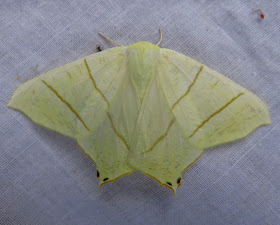A very productive mothing session was held recently at the country park on Friday 7th. I joined Dave Grundy and Chris Williams visiting from the Midlands and between us we set up 16 moth traps across the park including at East Mersea Point.
By dawn on Saturday over 160 species of both micro moth and macro moth had been recorded with a final tally still to come. The warm and muggy evening was perfect for moth activity and there was plenty to keep us interested.
One garden tiger was noted, pictured above, always a highlight here as numbers elsewhere in southern England continue to decline.
By dawn on Saturday over 160 species of both micro moth and macro moth had been recorded with a final tally still to come. The warm and muggy evening was perfect for moth activity and there was plenty to keep us interested.
One garden tiger was noted, pictured above, always a highlight here as numbers elsewhere in southern England continue to decline.
The clouded magpie pictured, was one of the few macro moths recorded on the night for the first time here.
One of the other new moths for the site was the tiny small marbled, an immigrant trapped near the beach.
One of the other new moths for the site was the tiny small marbled, an immigrant trapped near the beach.
The most notable micro-moth was seeing three boxworm moths - a strikingly big micro with a slight purplish sheen to its wings. It's discovery is bad news for gardeners with box hedges as the caterpillars strip the leaves off box plants. It is spreading fast across Essex moving out from the London area, the first sighting at the park last summer, now three in one night this summer here.
Another moth continuing to spread but with negligible impact is the festoon. A woodland species it was first noted at the park in 2013 and on Friday over 15 individuals were noted.
A few lackey moths were found, this female noted at a trap close to the beach. One or two ground lackeys were also found in traps near the saltmarsh.
The orange moth has become a regular each summer, this individual above being one of the darker forms.
A handful of the delicate rosy footman moths were noted, showing their salmon pink colouring. It seemed a good night for them.
Just one scarce silver lines was found, in the car park area, a regular during July.
The dark spectacle was of local interest for the park.
A couple of peach blossoms were noted, their markings helping them to hide amongst the bramble flowers.
Several swallow-tailed moths came to the traps, this one resting on the white sheet on the ground.
A coastal speciality is the sulphur pearl whose caterpillars feed on the wild carrot plants growing along the coast. A couple were noted on the evening, this one with a faded hint of yellow on the wings.
Chris Williams did very well with his eight or so traps as he found 16 great silver diving beetles in his. A freshwater beetle, it has been on the decline nationally but this night's tally here suggests a very healthy local population.












No comments:
Post a Comment